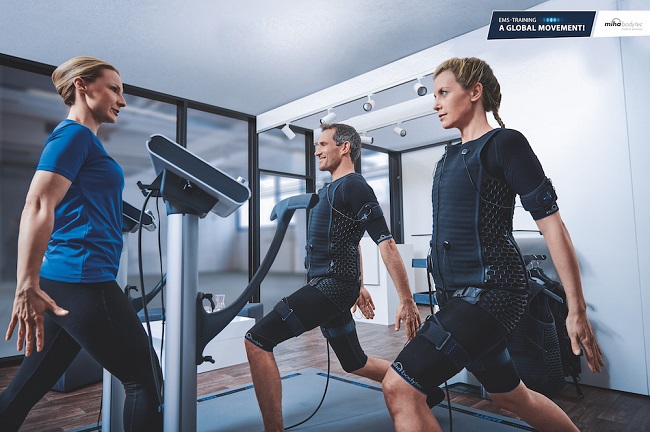On Location From Sibec 2021: What is ahead for Fitness Industry?

Athletech News attended Sibec 2021 in Phoenix, AZ last week. As our first in-person event of 2021, it was refreshing to be part of 240+ suppliers and buyers from the fitness industry. We were inspired by the energy and enthusiasm of attendees and the overwhelming optimism for the future of the fitness industry.
Fitness leaders and entrepreneurs hail Sibec as being their most important event of the year. Sibec 2021 was no different.
“Not only do we come to Sibec to meet with potential buyers, but it is our opportunity to collaborate with fellow suppliers. It provides us the chance to understand each other’s opportunities and learn of advances in products. There are few other places where the best of fitness products converge,” said virtual training platform FlexIt founder Austin Cohen.
The sense of optimism was intertwined with an undeniable level of anxiety about what lay ahead for the fitness industry, especially for owners of brick-and-mortar gyms and manufacturers of commercial grade gym equipment. Many gym owners who attended Sibec saw 2020 as the hardest year of their careers. For manufacturers, the lack of money gym owners have to invest in new equipment provides a challenge for the years ahead. Many companies have pivoted to offer more in-home equipment vs. commercial products to adjust for the steep rise in at-home exercise.
Other conversations throughout the three-day Sibec 2021 included the obstacles faced by increased costs associated with moving products out of China. One equipment manufacturer said they have been forced to add as much as 8% to the price of their equipment to account for the higher freight rates. At the beginning of 2020, it cost around $2,000 to ship a container from China to Europe. Now, some companies are being quoted as much as $14,000. The issue, caused by a shortage of shipping containers in China and other parts of Asia, is yet one more obstacle the industry is currently facing.
Beyond the mix of optimism and trepidation for what lies ahead, other key trends included the need to reinvent the gym, wellness services as an extension of traditional physical fitness centers, and the growth of connected and digital fitness.
Reinventing the Gym
With the recent announcement from the CDC on relaxed mask mandates, gym attendance is on the rise according to recent reports. For gym owners and operators this comes as music to their ears after 14 long months of lost revenue. Gyms, eager to welcome people back, are finding their members eager for personal connection and a more vigorous workout. In a recent Insider article, Equinox announced on Tuesday, May 18th, just after New York relaxed restrictions, that they had their busiest day since March 2020. According to Equinox, the same week saw new-membership sales in New York up 55% versus the week prior.
While the gym is surely not dead, the future of traditional fitness centers is in question. Gyms are under pressure to reimagine their spaces and their offerings. Consumers have invested in alternative methods to stay fit utilizing products from Peloton, Mirror and Tonal. In addition to new cutting-edge equipment, increased usage in fitness apps and digital programming have enabled people to workout at home at lower costs. Many may be reluctant to depart from their newly established fitness habits.
There was strong representation of traditional and connected fitness equipment at Sibec 2021. Companies like Jacob’s Ladder, CLMBR, Woodway Treadmills and Echelon were popular suppliers that buyers were eager to engage with. This comes as a recent industry report marked the global market for physical fitness equipment at an estimated $13.5BN as of 2020 with projected growth to $18.5B by 2026, a CAGR of 5.3% over the analysed period. Cardiovascular Training alone is projected to record a 5.7% CAGR and reach $11B during the same time period.
Connected Fitness
While gym owners came to Sibec to understand the latest in traditional equipment, many left considering investments in innovative software and services not previously offered. Examples of this include products such as Virdio, an augmented reality technology solution which allows gyms to “bring the gym to a member’s home” in a fun interactive way that makes at-home fitness more exciting without the need to invest in heavy and expensive equipment.
Virdio’s business model, which allows gyms to quickly connect trainers and fitness instructors to at-home members, is a minimal investment as they only are charged if a member signs up and takes a class. This kind of model bodes well for gyms as they try to innovate and keep costs low. When we talked to Founder Arjun Rishi about the response he got, he said that gym owners he thought might have previously been reluctant to consider new solutions for their gyms were overwhelmingly open and anxious to test out the product. “Gyms know they need to meet their customers where they are, which is currently at home,” said Rishi. “From all the studies we have seen, the members not returning to the gyms range between 20% and 30%. There are outlier studies that go as high as 40%. Our feeling is that a large portion of the members will return, some will want to work out a few days at the gym and the rest of the week at home, a true hybrid member. Our solution enables gyms to engage their members when they workout at home.”
Wellness as an Extension to Fitness Centers
Other gym operators pointed to wellness and self-care products as ways they plan to keep their gym members satisfied and engaged. Am-Finn Saunas, a leader in commercial grade sauna and steam rooms, were met with increased attention from gym owners. With a variety of offerings (including a new residential sauna for those who want to enjoy spa-like services at home), owners, who had previously not considered offering such amenities, were highly engaged during meetings with the Am-Finn representatives. One gym owner commented, while he typically shied away from spa-like services, he knew that he needed to give his members something different. He also felt that with a variety of pricing options and easier build out, the saunas were now more obtainable.
Miha bodytec, which offers EMS (Electro Muscular Stimulation) training, is another example of a product extension for existing gyms and studios. EMS training is traditionally a 20 minute workout that stimulates the muscle 30% more than a traditional workout. This type of training uses a direct impulse to the muscle, similar to the type of impulse your body naturally produces. When speaking to the team they reported increased attention from not only training facilities but gyms, spas and recovery rooms as companies look to diversify their offerings and provide their customers the latest and most effective fitness solutions. With the recent approval to use EMS for medical use, Miha bodytec feels well positioned for future growth and increased adoption.
It felt somewhat serendipitous that Sibec 2021 was occurring as federal, state and local governments were beginning to lift bans on mask wearing at fitness facilities and capacity guidelines were being loosened around the country. This couldn’t have come at a better moment as gym owners and operators are desperate to get their members back into their gyms. While the question lingers…how many will come back, operators are determined to reopen (albeit sometimes with fewer locations or reduced offerings) with the hope that the balance of 2021 will help them begin to regain what they lost during the pandemic.



